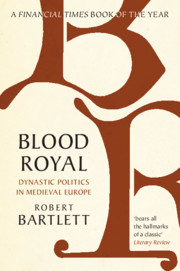Book contents
- Blood Royal
- The James Lydon Lectures in Medieval History and Culture
- Blood Royal
- Copyright page
- Dedication
- Contents
- Figures
- Preface and Acknowledgements
- Abbreviations
- Introduction Royal Families
- Part I The Life Cycle
- Part II A Sense of Dynasty
- Chapter 8 Names and Numbering
- Chapter 9 Saints, Images, Heraldry, Family Trees
- Chapter 10 Responses to Dynastic Uncertainty: Prophecy and Astrology
- Chapter 11 Pretenders and Returners: Dynastic Imposters in the Middle Ages
- Chapter 12 New Families and New Kingdoms
- Chapter 13 Dynasties and the Non-Dynastic World
- Conclusion
- Book part
- Notes
- Bibliography of Works Cited
- Index
Chapter 9 - Saints, Images, Heraldry, Family Trees
from Part II - A Sense of Dynasty
Published online by Cambridge University Press: 09 July 2020
- Blood Royal
- The James Lydon Lectures in Medieval History and Culture
- Blood Royal
- Copyright page
- Dedication
- Contents
- Figures
- Preface and Acknowledgements
- Abbreviations
- Introduction Royal Families
- Part I The Life Cycle
- Part II A Sense of Dynasty
- Chapter 8 Names and Numbering
- Chapter 9 Saints, Images, Heraldry, Family Trees
- Chapter 10 Responses to Dynastic Uncertainty: Prophecy and Astrology
- Chapter 11 Pretenders and Returners: Dynastic Imposters in the Middle Ages
- Chapter 12 New Families and New Kingdoms
- Chapter 13 Dynasties and the Non-Dynastic World
- Conclusion
- Book part
- Notes
- Bibliography of Works Cited
- Index
Summary
This chapter looks at cultural expressions of dynastic consciousness. Some dynasties associated themselves with a particular saint, on occasion one drawn from their own family, as in the case of Wenceslas and the rulers of Bohemia or St Louis and the Capetians, and such family connections were publicly celebrated in images and writing. Murals and statues of forebears conveyed a message of dynastic continuity, and examples can be found from the Carolingian period down to the late Middle Ages, with notable cases being the forty-one statues of kings of France in the royal palace in Paris and the nineteen of the counts of Barcelona and kings of Aragon in the royal place in Barcelona. The development of heraldry in the twelfth century presented a new, public and visual, way of expressing dynastic identity, and royal families adopted them early. By the end of the Middle Ages, elaborate coats-of-arms conveyed elaborate genealogical information. Simultaneously, graphic family trees were devised and developed, with sophisticated illustration and layout. In late medieval England they often took the form of long parchment rolls, ideal for expressing descent through time. Bernard Gui’s Tree of the Lineage of the Kings of the French is analysed in detail.
- Type
- Chapter
- Information
- Blood RoyalDynastic Politics in Medieval Europe, pp. 311 - 339Publisher: Cambridge University PressPrint publication year: 2020



